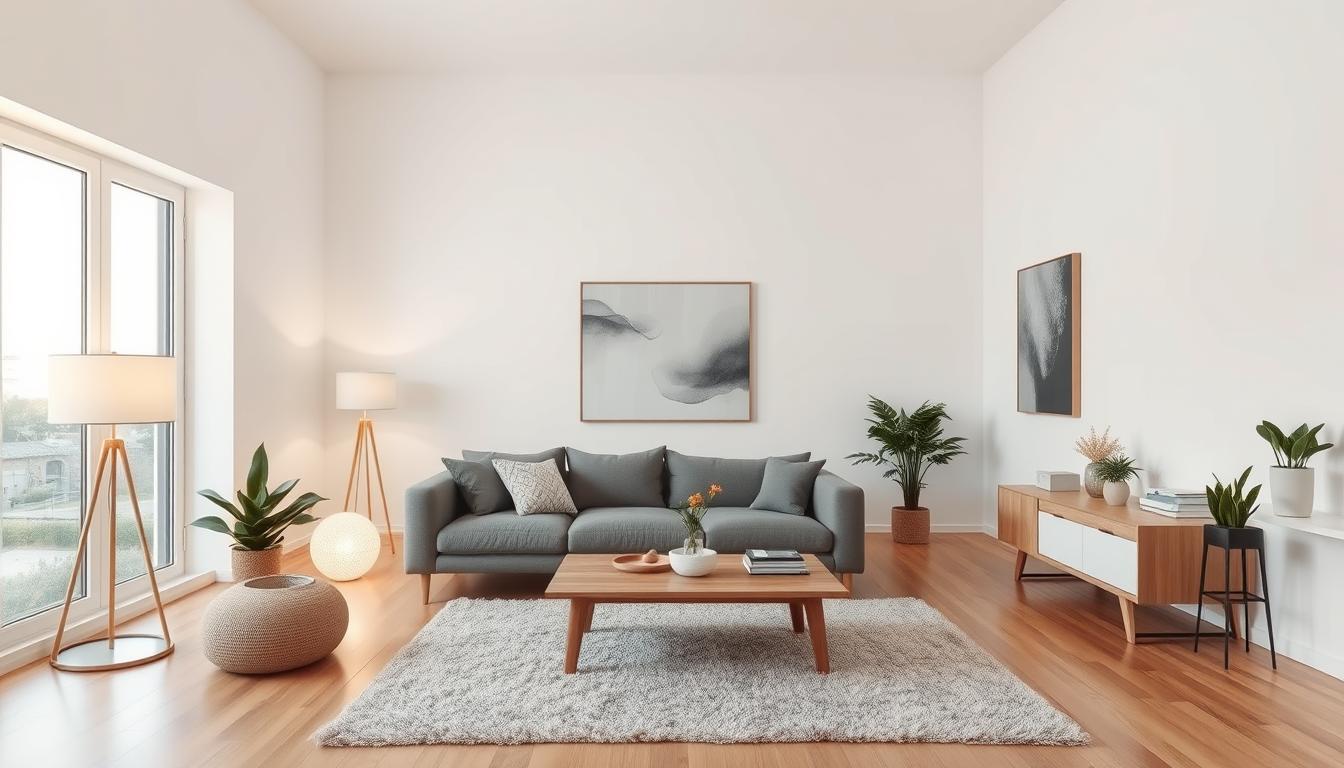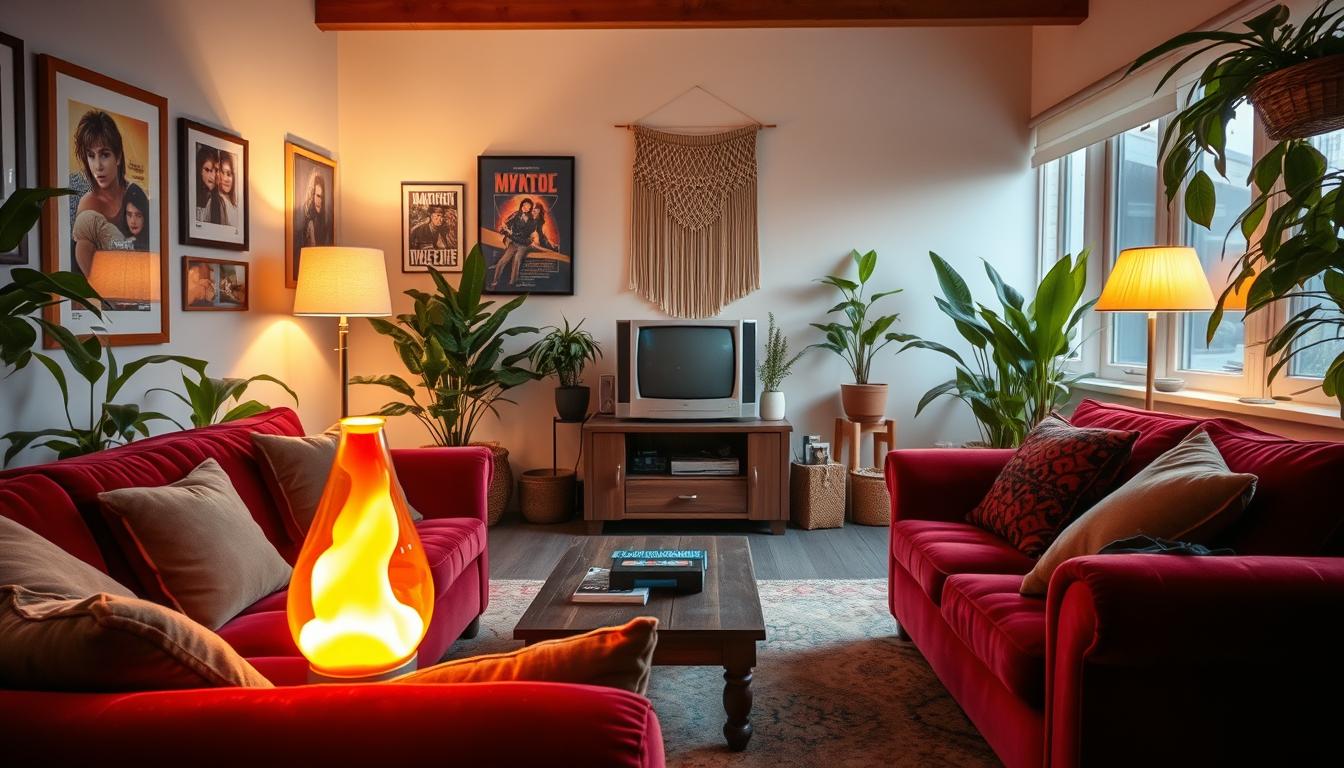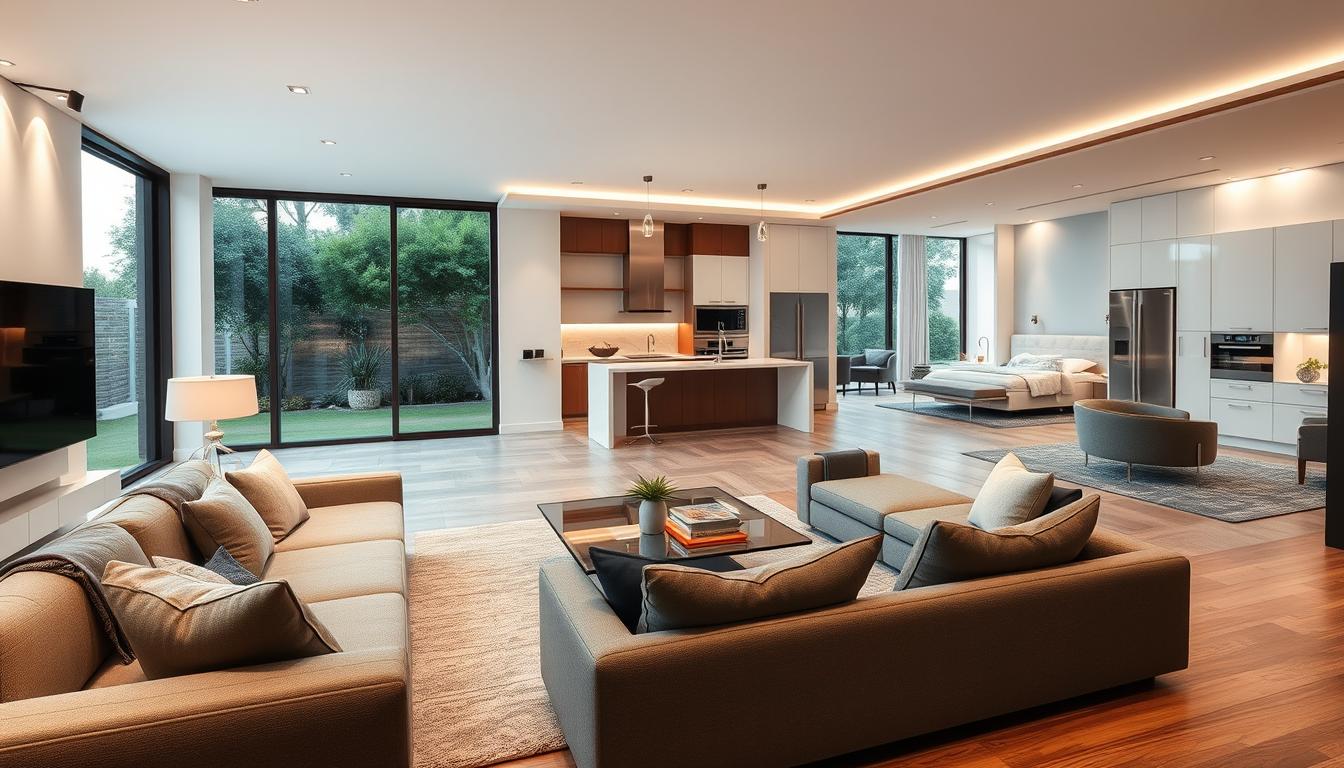Did you know that using the latest modern interior decorating ideas can boost your home’s value by up to 10%? Making your home stylish and welcoming is more than just looks. It’s also a wise choice. We’re here to help you make that happen.
Welcome to our detailed guide on trendy interior design homes. We’ll dive into the newest trends and ideas in interior design. Our aim is to give you the spark and know-how to turn your home into a chic retreat.
Key Takeaways
- Understanding the essence of trendy interior design
- Exploring modern interior decorating ideas
- Learning how to accessorize your space effectively
- Discovering the latest trends in home decor
- Transforming your living space into a stylish haven
Understanding the Essence of Trendy Interior Design
Adding the latest home decor trends to your space can seem hard. But, with the right tips, it’s easy. Trendy interior design is about mixing your personal style with function.
What Makes a Home Trendy?
Experts say a trendy home blends looks with use. So, what makes a home stand out? It’s about adding unique touches.
Some key traits include:
- A mix of modern furniture that is both stylish and comfortable
- Thoughtful color schemes that enhance the mood of the space
- Innovative use of textures and fabrics to add depth
Key Elements of Trendy Design
To get a trendy vibe, think about these elements:
- Modern Furniture: Choose pieces that are both useful and stylish. For example, a sleek sofa can be a great centerpiece for your living room.
- Color Schemes: Pick a palette that’s modern and shows your style. Neutrals with bold accents are very trendy.
- Textures and Fabrics: Mixing different textures and fabrics adds sophistication. Try combining smooth with rough textures.
By understanding and using these elements, you can make a home that’s trendy and truly yours.
Popular Interior Design Styles Today
Today, several interior design styles are popular. They show our personal tastes and change how we live at home.
Here are three top styles known for their unique looks and appeal.
Minimalism: Less is More
Minimalism focuses on simplicity and clean lines. It makes spaces calm and clear. This style uses neutral colors like white, beige, and gray.
Key Features of Minimalism:
- Simple and clean lines
- Limited color palette
- Clutter-free spaces
- Use of natural materials
Bohemian: Color and Texture Combinations
Bohemian style celebrates your unique self with bold colors, textures, and patterns. It’s all about being creative and mixing vintage and global items.
Characteristics of Bohemian Style:
- Vibrant color palette
- Mix of textures and patterns
- Incorporation of vintage and global elements
- Eclectic decor
Scandinavian: Function Meets Aesthetics
Scandinavian design blends function with beauty. It’s simple and comfortable. It uses natural materials and light colors for warmth and coziness.
Elements of Scandinavian Design:
- Functionality and simplicity
- Use of natural materials
- Light color palette
- Cozy and inviting atmosphere
To understand these styles better, let’s look at their main features in a table.
| Style | Color Palette | Key Features |
|---|---|---|
| Minimalism | Neutral tones (white, beige, gray) | Simple lines, clutter-free, natural materials |
| Bohemian | Vibrant and eclectic | Mix of textures and patterns, vintage and global elements |
| Scandinavian | Light and neutral | Functionality, natural materials, cozy atmosphere |
Knowing these styles helps you decorate your home wisely. You can make sure your space is stylish and functional.
Color Schemes That Define Trendy Homes
Color schemes are key in modern homes. The right colors can make your space look chic and welcoming. Trendy homes mix timeless neutrals with bold colors for personality.
The Power of Neutrals
Neutral colors are essential in modern decor. Shades like beige, white, and gray are clean and timeless. They’re perfect for adding bold touches.
Using neutrals well means layering shades for depth. For example, beige walls with gray furniture and white accents look stylish. This makes it easy to change up your decor.
Bold Accents and How to Use Them
Bold colors add character to homes. You can use them in throw pillows, art, or furniture. The trick is to balance them so they enhance the space.
For a stylish home, use bold accents to create interest. A neutral room can be transformed with a vibrant art piece or colorful rug. This adds personality and shows off modern decor ideas.
Remember the 60-30-10 rule when using bold colors. 60% of the room should be neutral, 30% secondary, and 10% accent. This balance keeps harmony while allowing for creativity.
Furniture Trends for Modern Spaces
Modern living spaces are evolving, focusing on both looks and use. Today’s homes want furniture that’s stylish and practical. Pieces that do more than one thing are now in demand.
Multi-Functional Furniture
Multi-functional furniture is a big hit in today’s homes. With less space, items like storage ottomans and sofa beds are popular. They offer both comfort and utility.
- Storage ottomans that double as seating and storage units.
- Sofa beds that transform from a sofa to a bed with ease.
- Drop-leaf tables that can be expanded or minimized based on need.
These contemporary home decor trends help save space. They also make our homes more efficient and organized.
| Furniture Piece | Primary Function | Secondary Function |
|---|---|---|
| Storage Ottoman | Seating | Storage |
| Sofa Bed | Sofa | Bed |
| Drop-Leaf Table | Dining Table | Compact Storage |
Statement Pieces That Stand Out
Function is important, but statement pieces are also crucial. These items catch the eye with their unique design, bold colors, or new materials.
Some examples include:
- Bold-colored sofas that become the centerpiece of a room.
- Uniquely designed coffee tables that add a touch of personality.
- Artistic lighting fixtures that double as decorative elements.
Adding these trendy pieces to our homes makes them both useful and a reflection of our style.
Open Concept Living: The Heart of Trendy Homes
In trendy homes today, open concept living is more than a design choice; it’s a lifestyle. This design removes traditional barriers between living areas. For example, walls between the kitchen and living room are gone, creating a more spacious and airy feel.
Benefits of Open Floor Plans
Open floor plans are popular for good reasons. They offer several benefits that make them a favorite in modern homes. Some of the key advantages include:
- Increased Sense of Space: Open concept areas can feel larger and more expansive by removing walls.
- Enhanced Social Interaction: Open plans make it easier for family members and guests to interact while cooking, dining, or relaxing.
- Improved Natural Light: With fewer barriers, natural light can flow more freely, lighting up more areas of the home.
- Flexibility in Furniture Arrangement: Open concept spaces allow for more creative and functional furniture arrangements.
Designing with Zones in Mind
While open concept living has many benefits, it also has challenges. One challenge is keeping the space functional and defining different areas. Designers often use zoning techniques to solve this:
- Area Rugs: Area rugs can help visually define different zones within an open concept space.
- Lighting: Different lighting schemes can help differentiate areas, like pendant lights over a dining table or under-cabinet lighting in the kitchen.
- Furniture Placement: Strategically placing furniture can help create separate zones, like a sofa facing inward to create a cozy seating area.
By using these zoning techniques, homeowners can enjoy the benefits of open concept living. They can maintain a functional and stylish home interior.
Incorporating Technology into Interior Design
Technology and interior design are changing how we live. Our homes are becoming more stylish and useful. As tech gets better, it’s being used more in our homes, making them look better and work better.
Smart Home Devices to Enhance Style
Smart home devices are not just useful; they also make our homes look good. For example, smart lights can be changed with a remote or app. They can switch colors and brightness, giving us endless possibilities for chic home design inspiration.
Also, smart thermostats and security systems are key in modern homes. They offer comfort and safety.
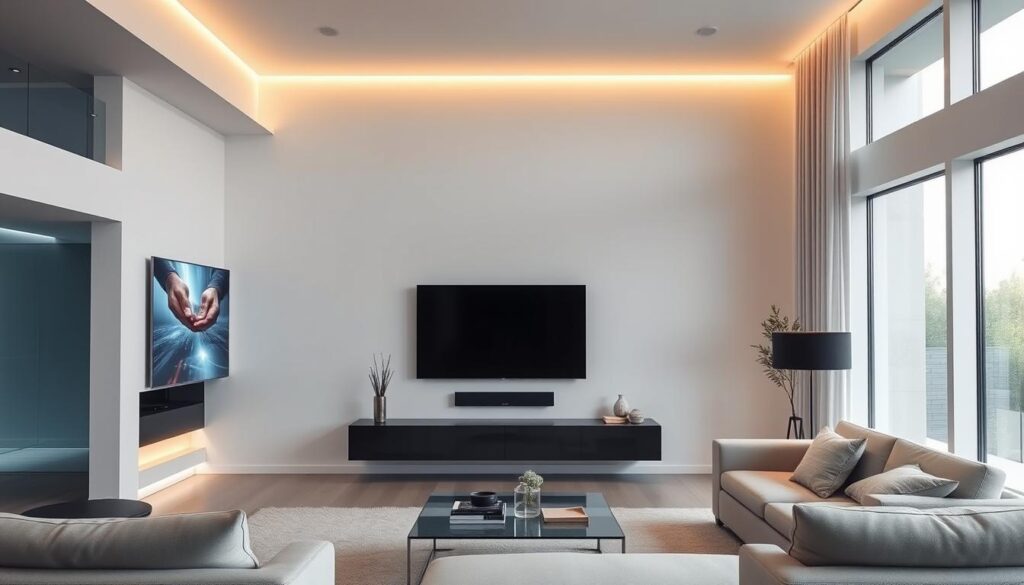
Innovative Gadgets for Functional Spaces
Innovative gadgets are turning our homes into highly useful places. Voice-controlled assistants like Amazon Echo and Google Home are central to smart homes. They control devices and give us information with just our voice.
Smart home automation systems also make managing our homes easier. These gadgets improve our homes’ function and add to their chic and modern feel.
Technology also lets us create personalized living spaces. With smart home tech, we can change lighting, temperature, and even wall colors to match our mood. This level of customization is now common in modern homes.
Sustainable Design Practices
Exploring trendy interior design homes shows us sustainable design is key now. People and designers are choosing eco-friendly options. These choices help our planet and make homes look great.
“Sustainability is more than being green,” an expert says. “It’s about making spaces healthy, efficient, and beautiful.” This change towards sustainable interior design means homes are stylish and good for the planet.
Eco-Friendly Materials and Their Benefits
Using eco-friendly materials is a big part of sustainable design. These materials are made in ways that are kind to the environment. For example, reclaimed wood, bamboo, and cork are great for floors and furniture. They’re sustainable and look amazing.
- Reclaimed wood adds character and history to a room.
- Bamboo is highly renewable and can be harvested in as little as three to five years.
- Cork is not only sustainable but also provides excellent insulation.
Want to learn more about making your home trendy? Check out our guide on trendy interior design.
Energy Efficiency in Trendy Homes
Energy efficiency is vital in sustainable design. It helps cut down energy use and lowers bills. Using LED lights, energy-saving appliances, and smart home tech are good ways to do this.
For example, smart thermostats adjust heating and cooling based on your habits. Smart lights turn off when you leave a room. These techs make our homes more comfy and eco-friendly.
“The future of interior design is not just about aesthetics; it’s about creating spaces that are in harmony with the environment.” – Design Expert
By choosing sustainable design, we make homes that are stylish, comfy, and green. As we go forward, finding new ways to be sustainable in design is crucial. It helps keep our planet healthy for the future.
Textures and Fabrics to Elevate Spaces
To make your home stylish, learn to mix and layer textures and fabrics. They are key to making your home look better and feel more welcoming.
Mixing patterns can make your home look unique and interesting. To do this, find a common thread like color or texture. For example, a bold floral with a subtle geometric pattern can make a room pop. Experts say, “A balanced mix of patterns can turn a room from ordinary to amazing.”
“The key to mixing patterns is to find a common thread, whether it’s a color, texture, or style, that ties everything together.”
Mixing Patterns for an Eclectic Look
Start with a main pattern and add secondary ones that match it. For instance, a bold stripe can be paired with a subtle polka dot or floral. Varying the pattern sizes is also important to avoid too much.
For more ideas on updating classic styles, check out our guide on reviving the 1970 home. It shows how to mix old with new decor.
Layering Textures for Depth
Layering textures adds depth and warmth to your home. Mix smooth, rough, soft, and hard textures for a cozy feel. For example, a leather sofa with a woven throw and a soft rug adds texture.
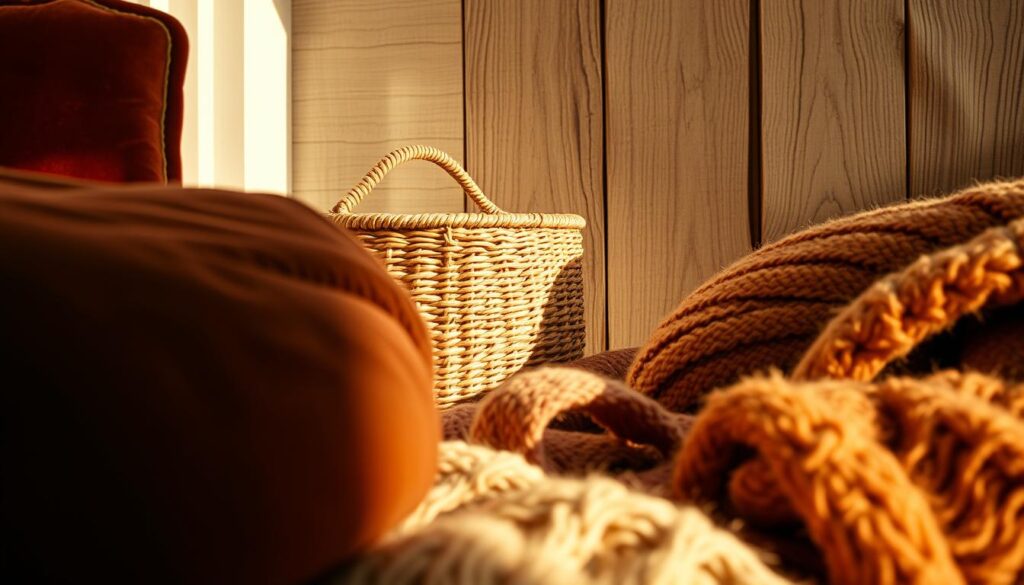
Remember the 3-touch rule: have at least three textures in a room. This could be a wooden table, a velvet chair, and a jute rug. This variety makes your space interesting and cozy.
In summary, mixing patterns and textures can greatly improve your home’s look. By learning to balance and combine them, you can create a stylish and welcoming space that shows off your personal taste.
The Impact of Lighting on Interior Aesthetics
Lighting is key in interior design. It changes how a room feels, making it welcoming, spacious, or cozy. The choices we make in lighting matter a lot.
Natural light is great for improving a room’s feel and mood. It makes spaces feel open and fresh. Plus, it cuts down on the need for artificial light.
Natural Light: Letting the Outdoors In
Natural light is loved for its warmth and connection to the outdoors. To get more natural light, use sheer curtains or blinds. They let sunlight in while keeping things private.
Here are some tips to boost natural light in your home:
- Use mirrors to reflect natural light into dark spots.
- Keep windows clean for better sunlight.
- Choose light-colored paints and finishes to reflect light.
Creative Artificial Lighting Solutions
Artificial lighting is important when natural light isn’t enough. There are many creative ways to light up your home. From table lamps to smart lighting systems, there’s a lot to choose from.
Let’s look at some popular artificial lighting options:
| Lighting Type | Ambiance Created | Energy Efficiency |
|---|---|---|
| Table Lamps | Cozy, Intimate | Variable |
| LED Strip Lighting | Modern, Sleek | High |
| Smart Lighting Systems | Customizable | High |
By mixing natural and artificial light, we can make spaces that look good and feel great. It’s all about finding the right balance.
Accessorizing for a Trendy Touch
Accessorizing is key to adding a trendy touch to your home. Artwork, decor, and plants can make your space unique and personal. They bring freshness and character to your home.
The Importance of Artwork and Decor
Artwork and decor are more than just extras. They’re essential for elevating your home’s style. Choosing the right pieces can add personality and character to your space. This makes it feel welcoming and shows off your taste.
When picking artwork, think about your room’s style and color. Modern spaces might look great with abstract or geometric art. Traditional rooms could benefit from classical or landscape pieces. Decor items like vases or sculptures add visual interest and depth.
| Type of Artwork | Suitable Room Style | Notable Features |
|---|---|---|
| Abstract Art | Modern, Contemporary | Unique patterns, vibrant colors |
| Classical Art | Traditional, Vintage | Elegant themes, detailed craftsmanship |
| Geometric Art | Minimalist, Modern | Shapes, patterns, monochromatic colors |
Plants: Bringing Life Inside
Plants are also key in accessorizing your home. They purify the air and bring nature indoors, making your space more inviting. There’s a plant for every style and care level, from low-maintenance succulents to lush greenery.
When picking plants, think about lighting, temperature, and care needs. Bright, sunny rooms are perfect for plants like sunflowers or orchids. Less sunny rooms do better with plants like snake plants or peace lilies.
By carefully choosing and placing artwork, decor, and plants, you can add a trendy touch. This touch reflects your personality and style.
Creating a Cohesive Look Throughout Your Home
A consistent theme makes your home feel more connected and stylish. Choosing a theme that shows your personal style makes your living space beautiful and useful.
Selecting a Unifying Theme
To get a cohesive look, pick a theme that links all rooms. Use modern decorating ideas like a consistent color scheme or furniture style. This way, your home feels connected.
Designing Seamless Transitions
Smooth transitions between rooms are key for a cohesive look. Use trends like open floor plans and simple decor. This design makes your home welcoming and harmonious.
With these strategies, your home will look cohesive, stylish, and truly show your taste.

